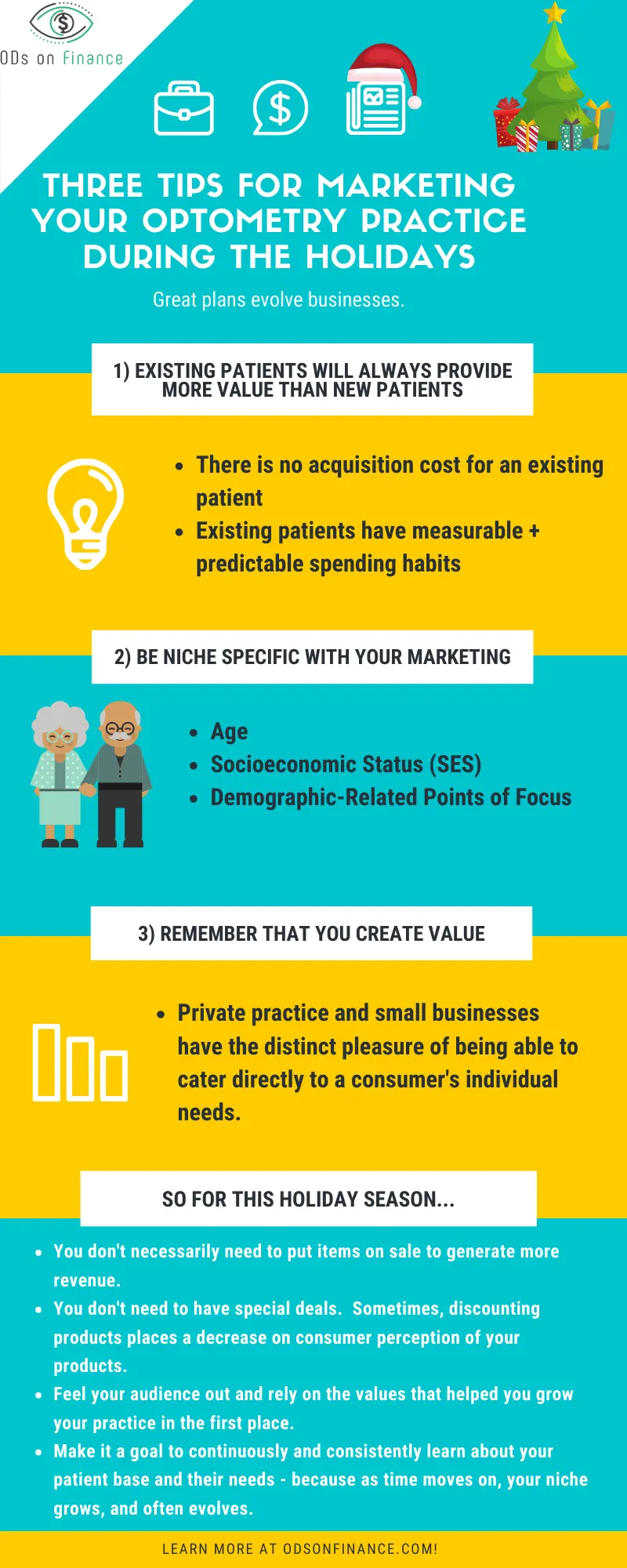Three Tips for Marketing Your Practice During the Holidays

With the Holiday season fully upon us, gift purchasing and self-indulgence traditionally reaches an all time high. In fact, with Black Friday happening just a day before writing this article, I decided to analyze some shopping tendencies of myself and society as a whole and see what parallels I could draw to patient spending trends in private practice.
1) Existing Patients will always provide more value than New Patients
If you've read any business book or sat in a practice management class, you've undoubtedly heard this. Existing patients will always provide more value than new patients. The reasoning behind this stems from two major reason:
To acquire a new patient you need to spend. This spending takes multiple forms. One form is time. Patient recruiting can occur through participating in community groups/events or it can occur at events such as small business meetings or Chamber of Commerce mixers. Another form is actually money spent through internet/social media advertising, mailings and TV/radio spots.
Now take a look at your existing patients. The most it probably costs to get them in your exam chair is a pre-appointment phone call or postcard. Perhaps they were diligent enough to make the appointment on their own.
b) Existing patients have measurable + predictable spending habits
With a new patient, you enter a complete different world. With your initial visit you must gauge many factors in order to find out what products this patient will steer towards. This can include extra time spent with both the doctor and optician. Now take a look at your existing patients. With the aid of EHR and note taking, as well as past experience, you can gauge exactly what an existing patient and subsequently what the patient will buy. Obviously consumerism is not an exact science, but familiar patients will almost always have predictive behaviors where as new patients will not.
2) Be Niche Specific with your Marketing
"Ok, keeping existing patients is a better and more cost effective strategy, so I shouldn't put any resources into recruiting new patients?" Absolutely not! While new patients are harder to get into your office and are less predictable in behavior, they still provide an added level of value to your practice, especially in up-and-coming practices that are not quite "mature."
What ages are you primarily seeing in your practice and what ages dominate your geographical area? Age and generation are important factors that play into your marketing strategy. While individuals in their 20s and 30s will respond great to trendy Instagram ads and emailed infographics, folks in their 50s or 60s may respond better to a traditional mailer or blog about ocular health.
b) Socioeconomic Status (SES)
You might have the flashiest, most attention-getting Gucci frame advertisement. But if those frames cost more than two weeks of wages of your average clientele, chances are, you'll waste a bunch of money marketing them. This is where Socioeconomic status (SES) comes into play. Marketing should focus on what your audience can afford and is willing to pay. Your marketing also does not have to be limited to products. Services, practitioner aptitude and staff attentiveness are all very marketable assets of a practice, just to name a few.
Marketing, especially at the SES level, will require a lot of trial and error. The best advice is to look at spending trends both at an internal level (your practice and what your patients buy) as well as an external level (what is the price point that individuals are willing to spend in your community). Also remember: although SES has a strong influence on what an individual can afford, that does not mean that there is not a market.
3) Remember that YOU create value
I remember looking at Yelp reviews for a corporate optometry office located in a mall. Through the slew of heavily negative reviews, most reviewers complained that they felt like they were getting ripped off. They would state the price they paid for either glasses or contacts then related it to the poor or general lack of service that they received. I realized that many of these products were products that myself and other private practitioners offered, and at a similar price! So why weren't we getting bombarded with disparaging reviews?


Facebook Comments